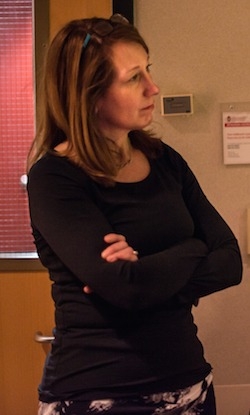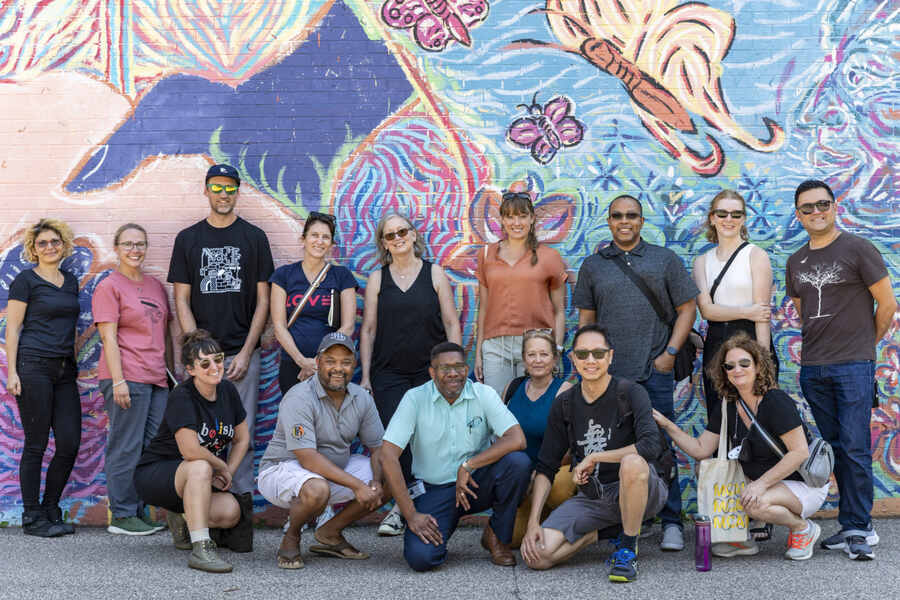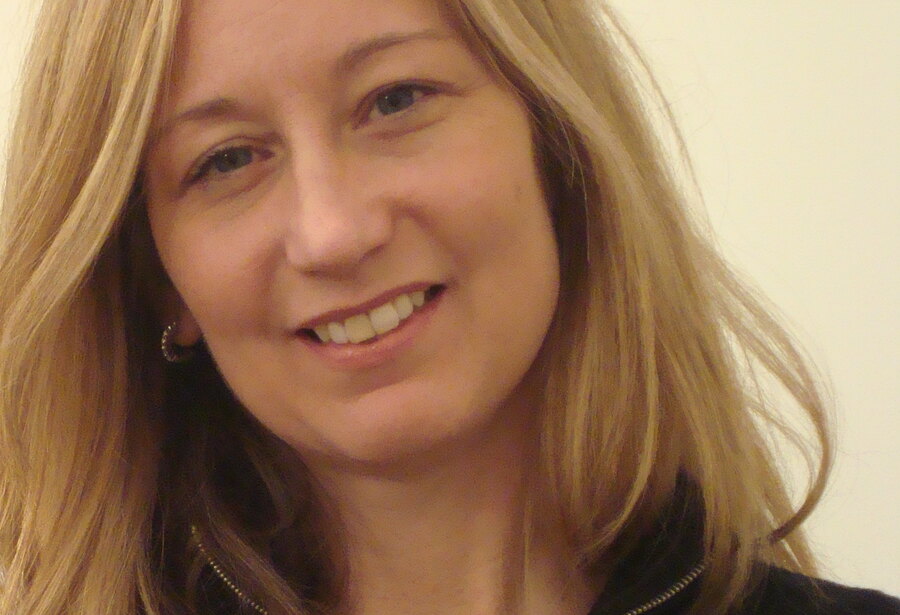“The willingness continually to revise one’s own location in order to place oneself in the path of beauty is the basic impulse underlying education.” —Elaine Scarry, On Beauty and Being Wrong
Some friendships begin in the brain, some in the heart. Some are born of shared projects or common purpose. Sometimes you get lucky and a friendship starts everywhere all at once—mind, heart, values, work—and radiates out from there, until you can’t tell where the joy of working together ends and that of thinking or simply being together takes over. Diane Ragsdale was that kind of friend to me and, when she died suddenly at a shockingly young 57 earlier this month, it became clear that she was such a friend for countless others as well.
We met sometime in 2004 or ’5. I don’t remember the moment, but I remember the feeling. Twenty years into my career, I knew that I’d found my work—leading a center for playwrights—but, as much as I loved and admired the writers at New Dramatists and colleagues across the field, I hadn’t found my posse, the people who thought and felt about theatre the way I did—who got what I wanted for it all. Then came Diane. She was working, often alone, as a program associate, then officer, in Theatre and Dance at the Andrew W. Mellon Foundation, before Susan Feder and Katie Steger joined a year later, as her boss and associate, respectively, both becoming her lifelong friends. Diane understood me, joined me, and made things happen. Most important, as she did throughout her uniquely catalytic career, she kept enlarging the circle.
In the days since her death, I’ve heard the same thing over and over, nearly verbatim. David Dower met Diane 20 years ago when he was running Z Space in San Francisco and feeling ancillary to the American theatre. “Because she existed and because she saw me, I knew I wasn’t crazy,” David told me. Philip Himberg, who headed up the Sundance Theater Lab at the same time (early 2000s) echoes this: “She saw me. She saw us. She saw the field.” Diane was a visionary whose gift was helping others refine and realize their own visions. Her Mellon sister-in-arms Katie Steger credits Diane as guide and mentor for almost every career move she’s made, an example of the way she took everyone seriously, ignored status, and believed that each person had something to contribute. As Katie put it, “She’d bring everybody into these big rooms to make shit happen.” Brain, heart, purpose, work—all in one jackpot of a person.

“Connector” is one of the words people commonly use to describe Diane. In this way she was a latter-day W. McNeil Lowry, the nonprofit theatre’s first patron saint, who infused Ford Foundation money into the embryonic resident theatre and made it a movement. In Zelda Fichandler’s words: “There was a ‘we,’ though we didn’t know each other. It was I, and him, and her out there somewhere.” That’s a little like how it felt to those of us running new-play labs and developmental theatre programs in the early aughts: P. Carl (and later Jeremy Cohen) at Playwrights’ Center, Dower (then Lisa Steindler) at Z, Himberg at Sundance, and myself at New Dramatists, as well as others across the country, who couldn’t get arrested by national foundations because we didn’t produce. We knew we were central to the theatre ecosystem; we knew that the playwrights we sheltered and loved and made space, community, and home for were at the heart of this loose, fragmented field. When Diane found us, we became a we.
We weren’t the only lucky ones. She sought out others like and unlike our gang: presenters and festival throwers, multi-arts labs and far-flung ensembles, as well as all the unique, urgent theatres whose seasons weren’t seasons at all but rather an ever-changing means of artistic production, like NY’s Foundry Theatre and the similarly different “Heffalumps,” as the Foundry’s pioneering leader Melanie Joseph called us un-categorizables. Diane roped everyone in, from the mammoth Oregon Shakespeare Festival to that Wile E. Coyote of festivals, Under the Radar. Diane understood economies of scale and scaled the peaks of aesthetic philosophy. She never lost sight of the art or artist, which is why you could always see the artist she was or had set out to be, why she could teach management skills to musicians and theatremakers and performers of any stripe. Why, Doctor Dolittle-like, she could talk to the Heffalumps.
As an activist-thinker, Diane understood the ecologies of culture. She mapped them at the intersection of aesthetics, economics, and ethics, circling versions of the question of how, in each of these ecosystems, we value what we value. She was an intellectual magpie, snatching curiosities from everywhere and paying them forward. P. Carl turned her on to Elaine Scarry’s On Beauty and Being Just, and she, in turn, made sure I read it. I started teaching it too, and have quoted it above, testament to the way she’d take a flame she’d lit from the torch of one of her beloved co-conspirators and use it to ignite another—or many others.
Beauty and justice were her twin beacons, everywhere she roamed. And roam she did. Her ArtsJournal.com blog was called “Jumper,” a name suggested by the journal’s editor Douglas McLennan when it became clear she’d be “jumping the pond” to marry a Dutch man, Jaap Boter. The name fit the kind of conversations she always had, Doug wrote me, “pushing ideas and ‘jumping’ conventional thinking.” The name rings right to me too—perfect for a person continually willing “to revise one’s own location” to place herself in the path of beauty and truth.
She traveled from her native home of St. Louis to college in New Orleans, graduate school in Kansas City, a doctoral program in Rotterdam, continuing MBA training in Palo Alto; she jumped from leadership jobs in Seattle to Idaho, New York, Alberta, and Minneapolis. She carried on a decade-long marriage, moving back and forth between many of these places and the Netherlands, where she joyfully leapt into the role of stepmother to two beloved daughters. Before her tenure at Mellon and all the teaching that followed, she jumped from premed to psychology, from acting to directing to marketing for a small ensemble theatre to turning around struggling music festivals before managing On the Boards, an important experimental performance venue in Seattle. From then on she slalomed the tortuous landscape of performing arts culture like Mikaela Shiffrin on a tear.
Diane didn’t just see her colleagues and fortunate friends. Driven by the future, she created, launched, and/or led at least three advanced degree programs to help up-and-coming generations make their visions real too: “Cultural Leadership” at the Banff Center for Arts and Culture and, later, at the Minneapolis College of Art and Design, and “Arts Management and Entrepreneurship” for performing artists at the New School. As a guest lecturer at the University of Wisconsin/Madison, she piloted a course on aesthetics in the business school, for God’s sake—“Aesthetics and Beauty” for MBA candidates!

Sometimes she jumped towards—love and learning, mostly. Her mind vaulted with the vivacious prowess of a brainiac Olympian with a case of intellectual ADHD. If you go to her Jumper blog, check out her reading lists (scroll to near the bottom of this page). They are endless and varied, and she read—then talked and taught—her way through every book there. “Diane lived at her learning edge,” her colleague Tim Cynova rightly claimed on his podcast, Work. Shouldn’t. Suck. Sometimes she jumped from: The too-common petty feudal lords of academia have little tolerance for visionaries like Diane. They like to dictate terms, and kickass world-changers like Diane don’t suffer dictation.
Diane’s unique brilliance was, I believe, this crazy combo of rigor and restlessness, which could make a conversation last for hours or days or forever. One topic she and I kept returning to: the intersection (her word) between commercial and nonprofit theatre, its history, present, and future. It was the subject of a now-famous conversation she facilitated between 25 producers on both sides of the equation in D.C. in 2011, and about which she reported in a short book, In the Intersection: Partnerships In the New Play Sector. She asked me to respond to the report for HowlRound and thus spurred me to articulate a (kinda) (then-) manifesto of my own, “What Price Idealism, or Who You Gonna Dance With?” Again, she inspired and incited. This uneasy, ever-evolving cross-economic relationship was the subject of her (now forever) unfinished dissertation, a draft of which almost everyone I spoke to for this tribute is trying to get hands on. I’d been working on a book of founding visions for American art theatres, and for years she wanted to discuss the great regional theatre founders, notably Margo Jones, Zelda Fichandler, and that first funder, Lowry. I gave her many leads, spent hours hashing over shared texts, and now I’m desperate to read her dissertation—a desire I’ve never had about anyone’s academic writing.
I want you to know this about Diane, especially if you’re a younger artist, administrator, or funder: Without her, many of us wouldn’t have made it. Two generations of “we” might have remained as her and him and them out there. Whole training programs wouldn’t exist, nor would one major platform I want to shout out in particular: HowlRound Theatre Commons. There’s a direct line from Diane Ragsdale to the founding of, first, the American Voices New Play Institute under Molly Smith and David Dower in 2009, which begat the Allen Lee Hughes New Play Producing Fellowships, which begat, at Emerson College, the HowlRound P. Carl had envisioned, which begat the Mellon National Playwright Residency Program, the Latinx Theatre Commons, and so much else. These were other people’s brain-children, but she believed in them and fought to have them funded. Without her, these seminal projects would have remained wishful. Through them she helped further the brilliant careers of a bajillion playwrights and theatremakers, as well as so many current field leaders who earlier worked in these programs, including Travis Ballenger, Kevin Becerra, Jamil Jude, Ronee Penoi, Amrita Ramanan, Dan Pruksarnukal, Erin Washington, and of course Jamie Gahlon and Vijay Mathew, both present at HowlRound’s birth and now overseeing its adolescence. The list goes on, as it does in so many galaxies, from new-play labs to the National Performance Network to the Network of Ensemble Theaters. I name these names for those of you coming after Diane and me and all the people with whom she made community. One person can make astonishing change, even in a field that appears to be fractured and immovable, even without a dean-ship, presidential seal, or huge institution under her direction.
Diane influenced national funding priorities well beyond her five or six years as an associate and officer (never director) at Mellon—touring her new boss Susan Feder, who came from the classical music world, through the island of misfit toys that is the American theatre, including the scrappy parts. She teamed up with other national funders to rethink—again and again—the relationships between buildings and organizations, art and institutions, the commercial and the nonprofit. She offered more than ideas—she offered data, funding studies like Dower’s Gates of Opportunity for Mellon and abetting what became Theatre Development Fund’s Outrageous Fortune: The Life and Times of the New American Play, authored by Ben Pesner and me. Those are the tip of the iceberg, as her research and reading (and all the research and reading she instigated) would have made more ordinary brains bleed.
Just as powerfully, she influenced our understanding of this culture we’re part of. Wherever she roamed—and she showed at every conference that ever was—she’d pull up a bar stool and one arts leader or another, one consultant or co-conspirator or two, would become her thinking buddies, until we fell asleep in our beers, even while she motored on. You can read proof of all that nonstop cogitation on Jumper in her numerous keynote speeches and essays. I wish this jumper had stayed still long enough to write books I could now hold and reread. I wish she’d lived a long enough life to write shelves of them. Truly, what’s already out there could fill volumes.
When my family and I moved to Seattle in 2014, we sought out On the Boards, which Diane had made mythic for me. She seemed to have always gotten to the best places ahead of me, like a cool older sister with amazing friends and an unlimited train pass, even though she was almost a decade younger. I wanted to go where she went—I’m still jealous of her years at Banff—and to know what she knew. When we moved back to New York, and I needed work and income to fill out my role as a program head of MFA Playwriting at the New School, she arranged a joint appointment for me to teach in the start-up year of her art entrepreneurship program there, sharing a cohort of artists from multiple disciplines with another lucky colleague-friend of hers, producer Mara Isaacs. We called the foundational class “Dreaming and Building.” It could serve as a title for her whole career.
Diane’s fire coursed through the whole of her: mind, heart, and body. It animated her ever-ready laugh and unstoppable stream of words. (She would joke that her sentences lasted two minutes, only after which she breathed.) Once, watching her hands, I noticed the beautiful new engagement ring she wore. I was searching for one myself, so she showed me the little storefront on the Lower East Side where she’d gotten it. I proposed to the mother of our then-3-year-old on the bench outside New York’s culinary wonder, Russ & Daughters, from which we could walk around the corner to pick out a ring. That jewelry store is gone now, as we discovered a few weeks before Diane too was gone.
In what I believe was her last published essay, from a year ago, she chews on a question by one of her favorite authors, Rebecca Solnit, who, like Diane, blends artistry, activism, and creative thought and in whose dazzling company Diane belongs. Solnit’s question “How do you calculate upon the unforeseen?” leads Diane to a contemplation of “indeterminacy,” as theorized by composer John Cage. In a world of unknowable outcomes, aren’t the ways arts organizations typically plan and strategize limited? In “recognition of the need to find radically new and beautiful alternatives to many of the ways of being, doing, and knowing” we have previously embraced, she imagines a “strategy of indeterminacy” to “arrive at destinations we cannot imagine, much less describe.”
If this was indeed her final public statement, it is a fitting one. As ever with Diane, it takes the form of a virtually unanswerable question. And it’s a haunting one, as those of us who knew her, loved her, thought, and worked alongside her try to imagine the unimaginable: a field, conference, conversation, classroom, festival, late-night brain-binge at which she is not. How can we calculate this unforeseen loss?
I don’t know how to make a word cloud, but if I did, I know the words that would pop out in majestic colored letters, because I’ve heard them in every conversation about Diane since I learned she’d died: BRILLIANT, FEROCIOUS, CURIOUS, GENEROUS, CONNECTIVE, INTENSE, COURAGEOUS, ARTIST. In her self-doubt, which was real, I suspect she would have used few, if any, of these terms to describe herself. But she was all of these things. I wish for everyone in the theatre a Diane Ragsdale in their life, someone who sees them, gives them a sense of belonging, and passes them fire.
Todd London (he/him) is a former managing editor of American Theatre and the author of numerous books on the theatre, including This Is Not My Memoir with Andre Gregory, An Ideal Theater, Outrageous Fortune, The Importance of Staying Earnest, and The Artistic Home, as well as two novels, If You See Him, Let Me Know and The World’s Room. A long-term artistic director of New York’s New Dramatists, he won the George Jean Nathan Award for Dramatic Criticism and was the first recipient of Theatre Communications Group’s Visionary Leadership Award.


